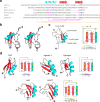Venom Peptides with Dual Modulatory Activity on the Voltage-Gated Sodium Channel NaV1.1 Provide Novel Leads for Development of Antiepileptic Drugs
- PMID: 32259093
- PMCID: PMC7088997
- DOI: 10.1021/acsptsci.9b00079
Venom Peptides with Dual Modulatory Activity on the Voltage-Gated Sodium Channel NaV1.1 Provide Novel Leads for Development of Antiepileptic Drugs
Abstract
Voltage-gated sodium (NaV) channels play a fundamental role in normal neurological function, especially via the initiation and propagation of action potentials. The NaV1.1 subtype is found in inhibitory interneurons of the brain and it is essential for maintaining a balance between excitation and inhibition in neuronal networks. Heterozygous loss-of-function mutations of SCN1A, the gene encoding NaV1.1, underlie Dravet syndrome (DS), a severe pediatric epilepsy. We recently demonstrated that selective inhibition of NaV1.1 inactivation prevents seizures and premature death in a mouse model of DS. Thus, selective modulators of NaV1.1 might be useful therapeutics for treatment of DS as they target the underlying molecular deficit. Numerous scorpion-venom peptides have been shown to modulate the activity of NaV channels, but little is known about their activity at NaV1.1. Here we report the isolation, sequence, three-dimensional structure, recombinant production, and functional characterization of two peptidic modulators of NaV1.1 from venom of the buthid scorpion Hottentotta jayakari. These peptides, Hj1a and Hj2a, are potent agonists of NaV1.1 (EC50 of 17 and 32 nM, respectively), and they present dual α/β activity by modifying both the activation and inactivation properties of the channel. NMR studies of rHj1a indicate that it adopts a cystine-stabilized αβ fold similar to known scorpion toxins. Although Hj1a and Hj2a have only limited selectivity for NaV1.1, their unusual dual mode of action provides an alternative approach to the development of selective NaV1.1 modulators for the treatment of DS.
Copyright © 2019 American Chemical Society.
Conflict of interest statement
The authors declare no competing financial interest.
Figures








Similar articles
-
A selective NaV1.1 activator with potential for treatment of Dravet syndrome epilepsy.Biochem Pharmacol. 2020 Nov;181:113991. doi: 10.1016/j.bcp.2020.113991. Epub 2020 Apr 23. Biochem Pharmacol. 2020. PMID: 32335140
-
A Transient Developmental Window of Fast-Spiking Interneuron Dysfunction in a Mouse Model of Dravet Syndrome.J Neurosci. 2018 Sep 5;38(36):7912-7927. doi: 10.1523/JNEUROSCI.0193-18.2018. Epub 2018 Aug 13. J Neurosci. 2018. PMID: 30104343 Free PMC article.
-
Three Peptide Modulators of the Human Voltage-Gated Sodium Channel 1.7, an Important Analgesic Target, from the Venom of an Australian Tarantula.Toxins (Basel). 2015 Jun 30;7(7):2494-513. doi: 10.3390/toxins7072494. Toxins (Basel). 2015. PMID: 26134258 Free PMC article.
-
Epilepsy-Related Voltage-Gated Sodium Channelopathies: A Review.Front Pharmacol. 2020 Aug 18;11:1276. doi: 10.3389/fphar.2020.01276. eCollection 2020. Front Pharmacol. 2020. PMID: 33013363 Free PMC article. Review.
-
A complicated complex: Ion channels, voltage sensing, cell membranes and peptide inhibitors.Neurosci Lett. 2018 Jul 13;679:35-47. doi: 10.1016/j.neulet.2018.04.030. Epub 2018 Apr 21. Neurosci Lett. 2018. PMID: 29684532 Review.
Cited by
-
Scorpion Venom: Detriments and Benefits.Biomedicines. 2020 May 12;8(5):118. doi: 10.3390/biomedicines8050118. Biomedicines. 2020. PMID: 32408604 Free PMC article. Review.
-
Two for the Price of One: Heterobivalent Ligand Design Targeting Two Binding Sites on Voltage-Gated Sodium Channels Slows Ligand Dissociation and Enhances Potency.J Med Chem. 2020 Nov 12;63(21):12773-12785. doi: 10.1021/acs.jmedchem.0c01107. Epub 2020 Oct 20. J Med Chem. 2020. PMID: 33078946 Free PMC article.
-
Scalable Biosynthetic Production of Knotted Peptides Enables ADME and Thermodynamic Folding Studies.ACS Omega. 2021 Oct 12;6(44):29555-29566. doi: 10.1021/acsomega.1c03707. eCollection 2021 Nov 9. ACS Omega. 2021. PMID: 34778627 Free PMC article.
-
Guidance on Dravet syndrome from infant to adult care: Road map for treatment planning in Europe.Epilepsia Open. 2022 Mar;7(1):11-26. doi: 10.1002/epi4.12569. Epub 2021 Dec 19. Epilepsia Open. 2022. PMID: 34882995 Free PMC article. Review.
-
Advancing Ion Channel Research with Automated Patch Clamp (APC) Electrophysiology Platforms.Adv Exp Med Biol. 2021;1349:21-32. doi: 10.1007/978-981-16-4254-8_2. Adv Exp Med Biol. 2021. PMID: 35138608
References
-
- Verret L.; Mann E. O.; Hang G. B.; Barth A. M.; Cobos I.; Ho K.; Devidze N.; Masliah E.; Kreitzer A. C.; Mody I.; Mucke L.; Palop J. J. (2012) Inhibitory interneuron deficit links altered network activity and cognitive dysfunction in Alzheimer model. Cell 149, 708–721. 10.1016/j.cell.2012.02.046. - DOI - PMC - PubMed
LinkOut - more resources
Full Text Sources
